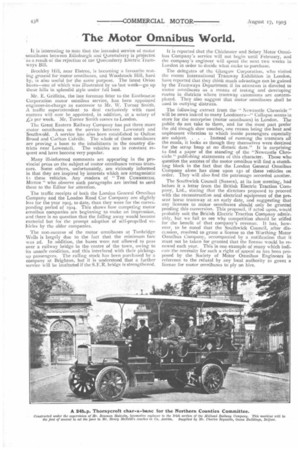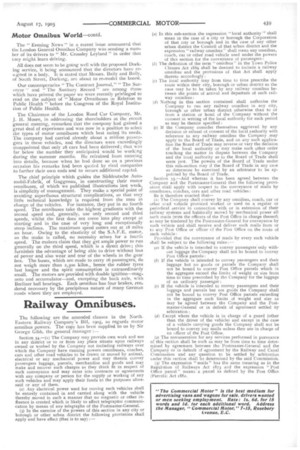The Motor Omnibus World.
Page 4

Page 5

If you've noticed an error in this article please click here to report it so we can fix it.
It is interesting to note that the intended service of motor omnibuses between Edinburgh and Oueensferry is projected as a result of the rejection of me Queensferry Electric Tramways Bill.
Brockley Hill, near Elstree, is becoming a favourite testing ground for motor omnibuses, and Woodstock Hill, hard by, is also useful for the same purpose. The latest Orion buses—one of which was illustrated by us last week—go up these hills in splendid style under full load.
Mr. E. Griffiths, the late foreman fitter to the Eastbouroe Corporation motor omnibus service, has been appointed engineer-in-charge as successor to Mr. W. Turner Smith. A traffic superintendent to deal exclusively with road matters will now be appointed, in addition, at a salary of £2 per week. Mr. Turner Smith comes to London.
The Great Eastern Railway Company has put three more motor omnibuses on the service between Lowestoft and .Southwold. A service has also been established to Oulton Broad and Carlton Colville. The whole of these omnibuses are proving a boon to the inhabitants in the country dis tricts near Lowestoft. The vehicles are in constant request and have become very popular.
Many ill-informed comments are appearing in the provincial press on the subject of motor omnibuses versus tram. cars. Some others, unfortunately, are viciously informed in that they are inspired by interests which are antagonistic t.) these vehicles. Any readers of "THE COMMERCIAL MOTOR" who observe such paragraphs are invited to send them to the Editor for attention.
The traffic receipts of both the London General Omnibus Company and the London Road Car Company are slightly less for the year 1905, to date, than they were for the corresponding period of 1904. This shows how competing motor omnibus companies are beginning to make an impression, and there is no question that the falling away would become material but for the prompt adoption of self-propelled vehicles by the older companies.
The non-success of the motor omnibuses at Tunbridge Wells is largely due to the fact that the minimum fare was 2d. In addition, the buses were not allowed to pass over a railway bridge in the centre of the town, owing to its unsafe condition, and this interfered with their pickingup passengers. The rolling stock has been purchased by a company at Brighton, but it is understood that a further service will be instituted if the S.E.R. bridge is strengthened, It is reported that the Chichester and Selsey Motor Omnibus Company's service will not begin until February, and the company's engineer will spend the next two weeks in London in order to decide what make to purchase.
The delegates of the Glasgow Corporation, who visited the recent international Tramway Exhibition in London, have reported that they think much advantage can be gained by the "framways Department if its attention is directed to motor omnibuses as a means of testing and developing routes in districts where tramway extensions are contemplated. They also suggest that motor omnibuses shall be used in outlying districts.
The following extract from the " Newcastle Chronicle " will be news indeed to many Londoners—" Collapse seems in store for the enterprise (motor omnibuses) in London. The public do not take to them, and for the most part prefer the old though slow coaches, one reason being the heat and unpleasant vibration to which inside passengers especially
are subject. . . Instead of running the tramcars oil the roads, it looks as though they themselves were destined for the scrap heap at no distant date." It is surprising to find a paper of the standing of the "Newcastle Chronicle " publishing statements of this character. Those who question the success of the motor omnibus will find a stumb. ling block in the fact that the London General Omnibus Company alone has close upon iso of these vehicles on order. They will also find the patronage accorded another.
The Southwick Council (Sussex), at its last meeting, had before it a letter from the British Electric Traction Company, Ltd., stating that the directors proposed to proceed with the reconstruction and electrical equipment of the present horse tramway at an early date, and suggesting that any licenses to motor omnibuses should only be granted pending this conversion. This proposal, if acted upon, would probabiy suit the British Electric Traction Company admirably, but we fail to see why competition should be stiffed for the benefit of that company's revenue. It has, however. to be noted that the Southwick Council, after discussion, resolved to grant a license to the Worthing Motor Omnibus Company, accompanied by a notification that it must not be taken for granted that the license would be renewed each year. This is one example of many which indicate the necessity for such a right of appeal as has been proposed by the Society of Motor Omnibus Engineers in reference to the refusal by any local authority to grant a license for motor omnibuses to ply on hire.
The " Evening News" in a recent issue announced that the London General Omnibus Company was sending a number of its drivers to " Mr. Crossley Leyland" in order that tney might learn driving.
All does not seem to be going well with the proposed Dorking service, it being announced that the directors have res.g-ned in a body. It is stated that Messrs. Bally and Bally, of South Street, Dorking, are about to re-model the board.
Our contemporaries "The Contract Journal," "The Surveyor" and "The Sanitary Record" are among those which have printed the paper we were recently privileged to read on the subject of "Motor Omnibuses in Relation to Public Health " before the Congress of the Royal Institution of Public Health.
The Chairman of the London Road Car Company, Mr. J. H. Moore, in addressing the shareholders at the recent general meeting, remarked that the company had gained a great deal of experience and was now in a position to select the types of motor omnibuses which best suited its needs. The company had carried already about a million passengers in these vehicles, and the directors were exceedingly disappointed that only 28 cars had been delivered ; that was far below the number they anticipated would be working during the summer months. He refrained from entering into details, because when he had done so on a previous occasion his remarks had been quoted by rival companies to further their own ends and to secure additional capital.
The chief principle which guides the Sfiddeutsche Auto. mobil-Fabrik, of Gaggenau, in constructing their motor omnibuses, of which we published illustrations last week, is simplicity of management. They make a special point of avoiding sujxx-Iluous structural complications, so that very little technical knowledge is required from the men in charge of the vehicles. For instance, they put in no fourth speed. The omnibuses take the highest gradients with the second speed and, generally, use only second and third speeds, whilst the first does not come into play except at starting and in the case of very long and exceptionally steep inclines. The maximum speed comes out at 18 miles an hour. Owing to the elasticity of the S.A.F.E. motor, as the make is called, no necessity arises for a fourth speed. The makers claim that they get ample power to run generally on the third speed, which is a direct drive; this furnishes the advantage of being able to drive without loss of power and also wear and tear of the wheels in the gear box. The buses, which are made to carry 16 passengers, do not weigh more than 2,300 kilos., hence the rubber tyres last longer and the spirit consumption is extraordinarily small. The motors are provided with double ignition—magneto and accumulator—and, excepting the back axle, with Berliner ball bearings. Each omnibus has four brakes, rendered necessary by the precipitous nature of many German roads where they are employed.
















